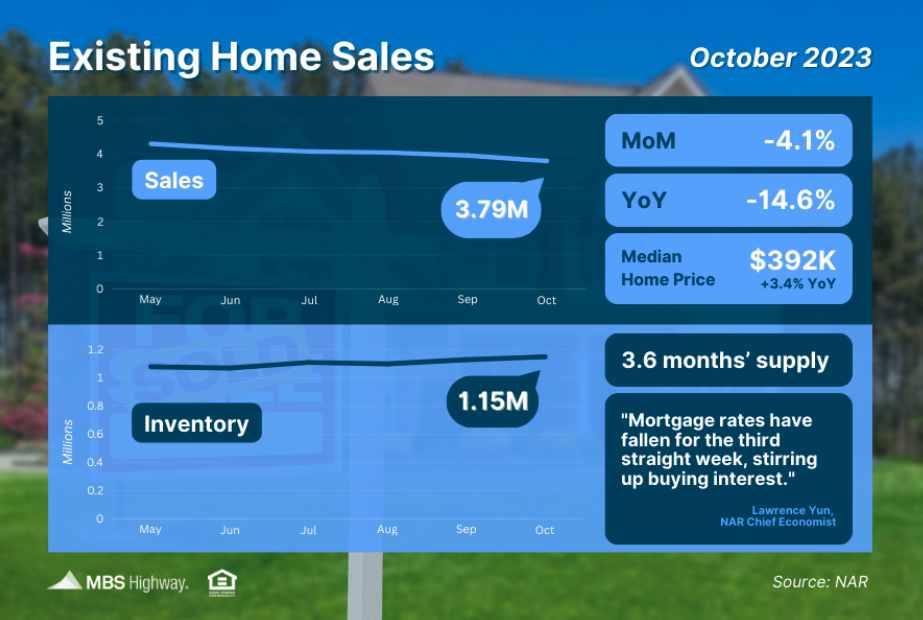Week of November 20, 2023 in Review
It was a quiet week ahead of the Thanksgiving holiday, but the markets gobbled up the latest news on Existing Home Sales and Jobless Claims. Plus, find out what a key recession indicator is signaling. Here are the highlights:
- Hope Ahead for Housing Inventory?
- Weekly Jobless Claims Decline More Than Expected
- What an Important Recession Indicator Is Saying
Hope Ahead for Housing Inventory?

Existing Home Sales fell 4.1% from September to October to a 3.79-million-unit annualized pace, reaching a 13-year low, per the National Association of REALTORS(NAR). Sales were also 14.6% lower than they were in October of last year. This report measures closings on existing homes and is a critical gauge for taking the pulse of the housing sector.
What’s the bottom line? The NAR noted that elevated mortgage rates and tight inventory remain key constraints on home sales. There were 1.15 million homes available for sale at the end of October, down from 1.22 million a year earlier and nearly half the levels seen in 2019. Plus, inventory is even tighter than that figure implies, as many homes counted in existing inventory are under contract and not truly available for purchase. In fact, there were only 737,000 “active listings” at the end of last month.
Despite these ongoing inventory constraints, homes continue to sell quickly (averaging just 23 days on the market in October). And 66% of homes sold in less than a month, showing that demand is strong for what’s available. In fact, the NAR noted that multiple offers are still occurring, especially on starter and mid-priced homes.
Yet, there was positive news for buyers as well. NAR’s Chief Economist, Lawrence Yun, noted that housing inventory is expected to improve heading into the spring.
Weekly Jobless Claims Decline More Than Expected
Initial Jobless Claims fell by 24,000 in the latest week, as 209,000 people filed for unemployment benefits for the first time. This decline was larger than expected and comes after first-time filings hit a three-month high in the previous week. Continuing Claims also fell by 22,000, as 1.84 million people are still receiving benefits after filing their initial claim. This was the first decline since September, when Continuing Claims hit a low of 1.658 million.
What’s the bottom line? Initial Jobless Claims remain relatively low on a historical basis, suggesting that employers are trying to hold on to workers. And while Continuing Claims declined in the latest week, they have risen by 182,000 since September and remain near the highest levels seen this year. This higher trend indicates that it’s becoming harder for people to find employment once they are let go.
What an Important Recession Indicator Is Saying
The Conference Board reported that Leading Economic Indicators (LEI) fell 0.8% in October, which is the nineteenth consecutive month of declines. The LEI tracks where the economy is heading, and its “trajectory remained negative, and its six- and twelve-month growth rates also held in negative territory in October,” explained Justyna Zabinska-La Monica, Senior Manager, Business Cycle Indicators.
What’s the bottom line? Historically, once the LEI turns negative, we have seen on average a 22-month lead time until the U.S. enters a recession. In fact, the last time we saw a stretch of negative reports like this was 2007 to 2009, ahead of the Great Recession.
Zabinska-La Monica added that, “The Conference Board expects elevated inflation, high interest rates, and contracting consumer spending – due to depleting pandemic saving and mandatory student loan repayments – to tip the U.S. economy into a very short recession.” While a recession is not a great thing for the economy, one positive aspect is that periods of recession are always coupled with lower interest rates.
Family Hack of the Week
November 28 is National French Toast Day. Make breakfast extra special with this easy Brioche French Toast recipe from All recipes.
- Cut brioche bread into 8 thick slices and set aside.
- In a small bowl, combine 1 teaspoon ground cinnamon, 1/4 teaspoon ground nutmeg, and 2 tablespoons sugar.
- Whisk cinnamon mixture with 4 eggs, 1/4 cup milk, and 1/2 teaspoon pure vanilla extract.
- Pour into a shallow container like a pie plate.
- In a 10-inch or 12-inch skillet, melt 4 tablespoons butter over medium heat.
- Dip bread in egg mixture and fry slices until golden brown, then flip to cook the other side.
- Top with fresh fruit and your favorite maple syrup.
What to Look for This Week
A plethora of housing news is ahead, starting Monday with October’s New Home Sales. Tuesday brings an update on home price appreciation for September via Case-Shiller and the Federal Housing Finance Agency.
Look for October’s Pending Home Sales on Thursday.
Also of note, the second reading on third quarter GDP will be reported Wednesday, while the latest Jobless Claims and the Fed’s favored inflation measure, Personal Consumption Expenditures, will be delivered Thursday.
Technical Picture
Mortgage Bonds ended the week trading near the bottom of a wide range with support at 101.035 and overhead resistance at 101.633. The 10-year broke above the 4.418% Fibonacci ceiling, which is now acting as support. The next ceiling is the 50-day Moving Average.
If you have questions about existing home sales or the jobless claims, contact me today.

